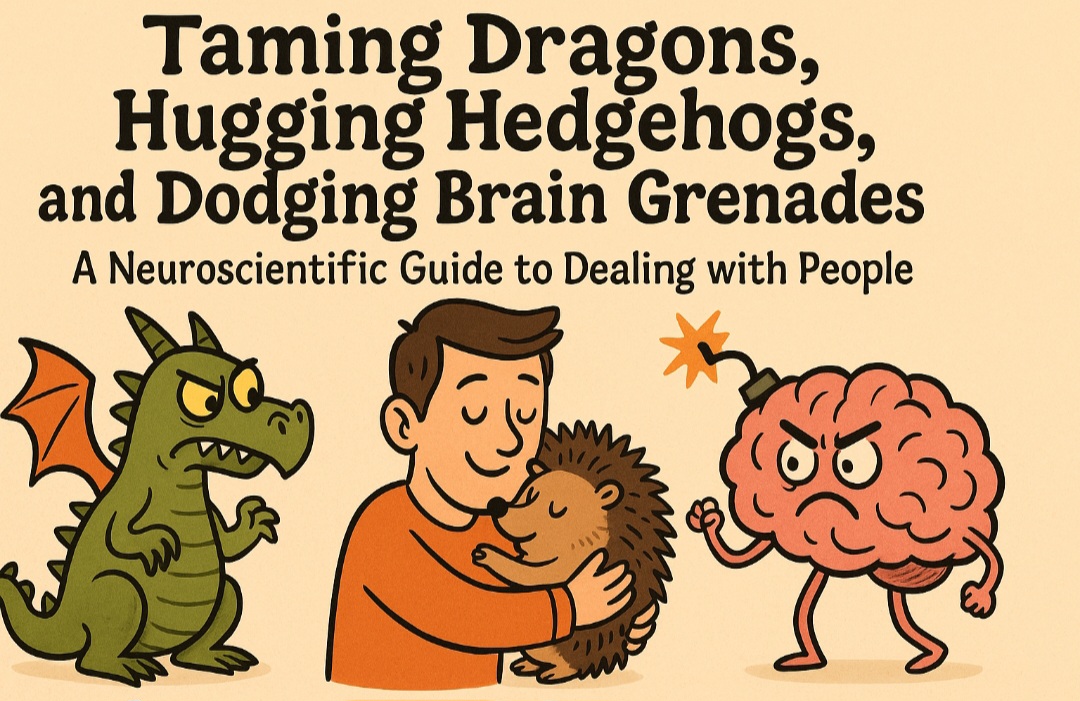Your cart is currently empty!
Dealing with people
A Neuroscientific Guide to Dealing with People
Dealing with people is a little like navigating a zoo without a map. Some roar, some bite, some curl into prickly little balls when threatened — and some will toss emotional grenades just to see what happens. The trick? Understanding that beneath the chaos, we’re all walking around with a three-pound blob of electrified jelly called a brain, and that brain runs the show.
So, let’s explore how neuroscience can help us deal with humans (yes, even the difficult ones) without losing our sanity.
1. Remember: Brains Are Basically Alarm Systems
When someone snaps at you in traffic or rolls their eyes during a meeting, it’s easy to take it personally. But neuroscience reminds us that the amygdala — the brain’s alarm bell — often hijacks logic, especially when dealing with people. Your boss’s angry rant? That’s their amygdala throwing a tantrum, not necessarily a carefully thought-out attack on your soul.
Tip: Instead of snapping back, imagine their brain yelling “Danger!” at a badly drawn stick figure. It helps you soften your response.
2. Mirror Neurons: Monkey See, Monkey Do
Ever notice how a friend’s yawn makes you yawn too? That’s mirror neurons at play. Humans are contagious creatures. If you radiate calm, curiosity, or even silliness, others are likely to copy you. Neuroscience gives us permission to be emotional influencers.
Tip: Want more kindness in your day? Start by dishing it out. Smile like your brain is running a free “kindness Wi-Fi” network.
3. Oxytocin: The Trust Hormone
Our brains release oxytocin when we feel safe, connected, or hugged (bonus points if snacks are involved). If you’re trying to build trust when dealing with people, forget grand speeches — small gestures like remembering someone’s name or offering genuine eye contact work wonders.
Tip: Next time you’re in a tough conversation, sprinkle in oxytocin builders — kindness, laughter, maybe even a cookie.
4. Prefrontal Cortex: The CEO of You
The prefrontal cortex helps us pause, plan, and not punch people (most of the time). But under stress, it goes offline faster than bad Wi-Fi. This explains why arguments escalate or why your teenager’s logic seems to vanish during curfew discussions.
Tip: If you feel your inner Hulk rising, take a brain break — deep breaths, a walk, or humming your favorite tune. Give the CEO of your brain a chance to clock back in.
5. Curiosity Over Judgment
Neuroscience shows curiosity lights up reward pathways in the brain, while judgment slams them shut. That annoying coworker? Instead of labeling them a “walking headache,” ask: What makes their brain tick this way? It transforms conflict into discovery. When dealing with people it is better to presuppose that everybody is behaving with good intention, even if it benefits only themselves. It also means that they are not necessarily out to annoy you specifically. So try to figure out how their behavior is benefitting them.
Tip: Pretend you’re a brain detective. Every odd behavior is just a clue.
In Conclusion: Humans Are Just Brains in Fancy Packaging
When we approach people with a little neuroscience in our back pocket, life gets easier. You realize that anger is just an amygdala flare, kindness is a neurochemical gift, and curiosity is brain candy.
So next time you’re dealing with a dragon, a hedgehog, or an accidental grenade-thrower, remember: it’s not you vs. them. It’s just brains doing their thing. And if you can meet them with empathy, humor, and maybe a cookie, you’ve already hacked the system.
by

Leave a Reply